The Arctic Fantasies of Edwin Landseer and Briton Riviere: Polar Bears, Wilderness and Notions of the Sublime
Diana Donald
Nineteenth-century images of the Arctic suggest that the sublime had lost its religious and moral dimensions. Diana Donald explores the work of the painters Edwin Landseer and Briton Riviere for evidence of a growing Darwinian awareness that humans and other species were united by a struggle for existence in a hostile environment.
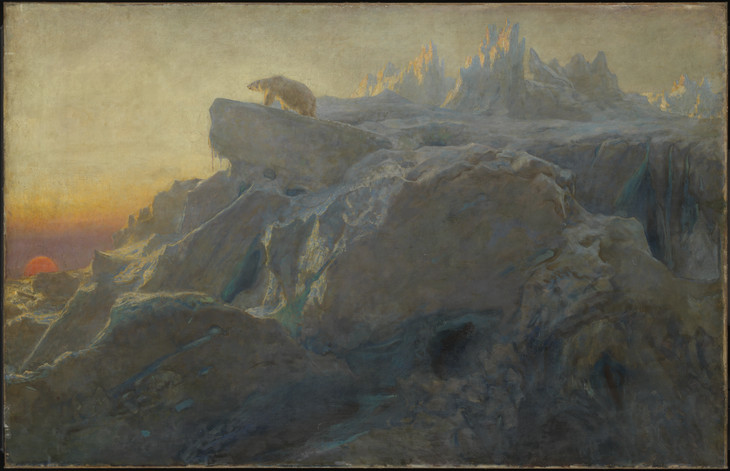
Briton Riviere 1840–1920
Beyond Man's Footsteps exhibited 1894
Oil on canvas
support: 1190 x 1845 mm
Tate N01577
Presented by the Trustees of the Chantrey Bequest 1894
Fig.1
Briton Riviere
Beyond Man's Footsteps exhibited 1894
Tate N01577
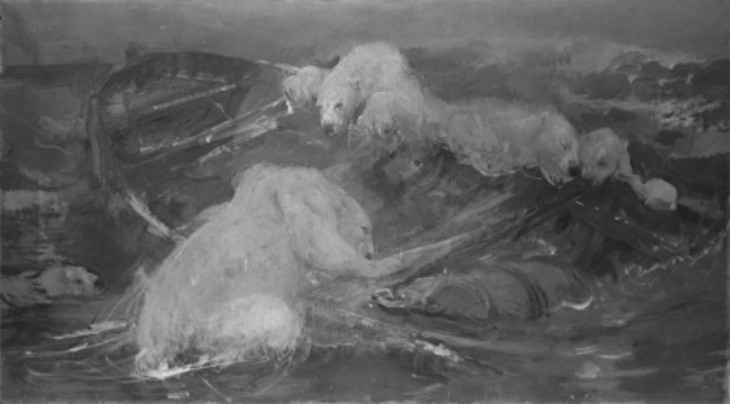
John Macallan Swan
The Abandoned Boat c.1870–1910
Oil on canvas
© Collection Rijksmuseum, Amsterdam
Fig.2
John Macallan Swan
The Abandoned Boat c.1870–1910
© Collection Rijksmuseum, Amsterdam
The scenes represented by Riviere and Swan belonged to a well-established genre: in the nineteenth century the Arctic and its creatures had become popular and highly emotive themes in the arts.7 Consciousness of human destruction of the environment, which the threat to polar bears has come to symbolise today,8 still lay in the future, but already there was the sense of violating a pristine world, often with tragic results. What one journalist of 1861 called ‘that mysterious temple which sits forever upon the forehead of the world’ was a place of wonder,9 inspiring religious awe, but also a place of ever-present danger of sudden or lingering death. In this essay I shall analyse images of the Arctic, especially those that refer to the loss of Sir John Franklin’s expedition. I am interested in what they reveal about changing notions of the sublime in the nineteenth century. In particular, I shall discuss concepts of the animal sublime through representations of polar bears in art and literature.
The disappearance of Sir John Franklin’s expedition with the loss of all the men on his two ships, the Erebus and Terror, obsessed the public in both Britain and America. They had set out in 1845 to undertake a renewed search for the North-West Passage, but all trace of them seemed lost until some troubling relics came to light in the late 1850s.10 As Russell Potter has shown, the fascination with Franklin’s fate was reflected in popular panoramas, in illustrated journals, and in the wide sales of books published by the leaders of various search and rescue expeditions in the 1850s. These books were often vividly illustrated by professional artists, working from sketches made by naval officers who had actually been on the expedition in question.11

'The Bear at Bay', Wood engraving from Elisha Kent Kane, Arctic Explorations in the Years 1853, '54, '55 1856
By permission of The British Library (2370 E8)
Fig.3
'The Bear at Bay', Wood engraving from Elisha Kent Kane, Arctic Explorations in the Years 1853, '54, '55 1856
By permission of The British Library (2370 E8)
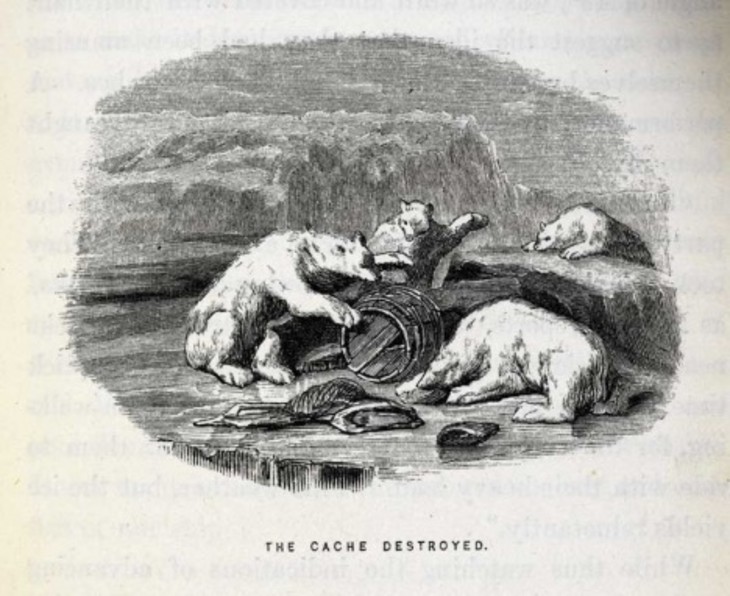
'The Cache Destroyed', Wood engraving from Elisha Kent Kane, Arctic Explorations in the Years 1853, '54, '55 1856
By permission of The British Library (2370 E8)
Fig.4
'The Cache Destroyed', Wood engraving from Elisha Kent Kane, Arctic Explorations in the Years 1853, '54, '55 1856
By permission of The British Library (2370 E8)
The books include many descriptions of encounters with polar bears. The men were struck by the strong bonds that linked family groups of these animals – especially the hungry females and cubs which were attracted to the ships – but nevertheless killed them without mercy.12 In the American Elisha Kent Kane’s Arctic Explorations in the Years 1853, ’54, ’55, some vignettes depict hunted bears at bay, attempting to resist dogs and spears, but in The Cache Destroyed the animals exact retribution as they raid an expedition’s food store, jeopardising the men’s ultimate survival (figs.3 and 4).13 We also gain an impression of other awe-inspiring sights of the Arctic – looming icebergs, darkness at noon, the aurora borealis – and of the fragility of expeditionary ships which might at any moment be crushed by the ice. James Hamilton’s image in Kane’s book of The Nip off Cape Cornelius Grinnell, Forge Bay shows human enterprise and ambition pitted against the terrible power of the elements, as the men tug desperately to free the ship and pull it to open water, under a menacing sky.14 ‘A Funeral on the Ice’ illustrated Sir Francis M’Clintock’s best-selling The Voyage of the ‘Fox’ in the Arctic Seas (1859, fig.5), the narrative of an expedition which had brought the first firm news of the fate of Franklin and his men. In line with M’Clintock’s emphasis on the religious and patriotic inspiration for his endeavour, it shows the decent Christian burial of a crew member who had been killed in an accident: the orderly rituals of civilised life are, it seems, preserved even in this unearthly and fearful environment, as the strange Arctic phenomenon of theparaselene or false moons arches over the funeral party.15 As we shall see, the finds made by M’Clintock and others of the relics of Franklin’s expedition told a very different story.
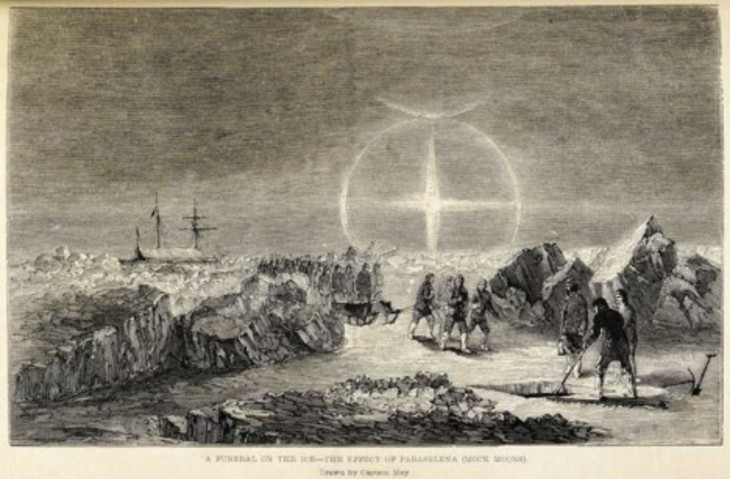
Edmund Evans after Captain May
'A Funeral on the Ice – The Effect of Paraselena (Mock Moons)', Wood engraving from Sir Francis Leopold M'Clintock, The Voyage of the 'Fox' in the Arctic Seas, 1859
By permission of The British Library (10460 D2)
Fig.5
Edmund Evans after Captain May
'A Funeral on the Ice – The Effect of Paraselena (Mock Moons)', Wood engraving from Sir Francis Leopold M'Clintock, The Voyage of the 'Fox' in the Arctic Seas, 1859
By permission of The British Library (10460 D2)
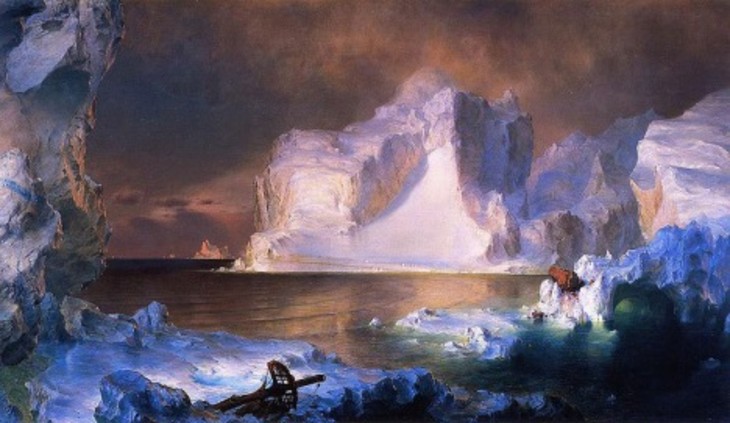
Frederic Edwin Church
The Icebergs 1861
Oil on canvas
© Dallas Museum of Art
Fig.6
Frederic Edwin Church
The Icebergs 1861
© Dallas Museum of Art
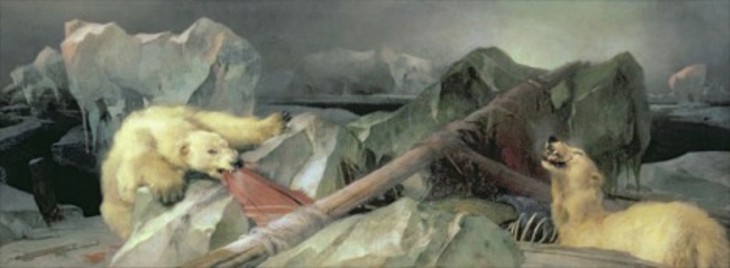
Sir Edwin Landseer
Man Proposes, God Disposes exhibited 1864
© The Bridgeman Art Library; Royal Holloway College, University of London
Fig.7
Sir Edwin Landseer
Man Proposes, God Disposes exhibited 1864
© The Bridgeman Art Library; Royal Holloway College, University of London
There is an insistent materiality in Landseer’s imagined scene, but there is also a sense of futility in the objects which surround the skeletons. Sir Francis M’Clintock, while diplomatically silent on Rae’s allegations of cannibalism, gave a detailed description of one find which ‘transfixed us with awe’. It was a boat that had been hauled overland on runners in a vain attempt to reach the Back River, containing two bodies. Both lacked their skulls, and one was a pile of disjointed bones. But the other more complete skeleton, evidently that of a stronger man, was surrounded by objects that he had salvaged from the expedition: perhaps – the reader could only surmise – he had stripped them from men he had eaten. They were both pathetic and bizarre, even ludicrous: not just furs, boots, guns and chocolate, but Captain Franklin’s inscribed silver plate, ‘worked slippers’, silk handkerchiefs, ‘scriptural or devotional works’ and – strangest of all – a copy of Goldsmith’s The Vicar of Wakefield.26 The fragility of civilisation, its utter irrelevance in this heart of darkness, could hardly have been more poignantly conveyed. Admittedly, Landseer does not show any improving literature or embroidered slippers among his scatter of objects. However, the telescope, the shreds of a coat or flag and the sail scattered round the human bones, which William Michael Rossetti called ‘the saddest of membra disjecta’, are telling enough.27
Landseer’s picture was cold-shouldered by Lady Franklin and the Admiralty, but it was greatly admired by reviewers and the general public.28 Admittedly, critics writing about Landseer’s art in retrospect a few years later, when his reputation was beginning to be questioned, sometimes remarked that the gruesome literalism of Man Proposes, God Disposes came very close to vulgar melodrama,29 but, at the time of its first exhibition, horror did not seem inimical to exalted emotion. The Art-Journaldescribed its ‘poetry, pathos, and terror’, its ‘tragic grandeur’. The Athenaeum found ‘epic’ quality, the Spectator enthused about the ‘living fire of imagination’, and the Saturday Review about ‘the force and height of the idea ... sublimity of sentiment’.30 Many of the traditional attributes of the sublime as defined by Edmund Burke in his Philosophical Enquiry into the Origin of Our Ideas of the Sublime and Beautiful of 1757 are indeed present here: the terror arising from darkness, solitude, obscurity and confusion; a sense of great undefined spaces stretching beyond the lateral limits of the picture; ferocious beasts, which like the Arctic itself, convey a sense of uncontrollable and menacing power.31 Yet in many ways Landseer’s image offers a deliberate challenge to earlier ideas of the sublime, as formulated notably by Burke and Kant.
Burke has often been hailed as an empiricist who analysed our impressions of the sublime and beautiful principally on a physiological or psychological basis.32 However, he largely rejected an associative element, and hence the likelihood of subjective diversity, in our responses to objects and natural phenomena. His insistence that all humans are affected in the same way by ‘the natural properties of things’ introduced an element of determinism into the Enquiry: the ‘great chain of causes’ through which human physiology was connected ‘even to the throne of God himself, can never be unravelled’.33 Indeed, Burke was convinced that such affects are providential: a sense of the sublime is closely connected with our divinely implanted instinct for self-preservation, and beauty, a spur to sexual passion, relates to our instinct for self-propagation. ‘The more accurately we search into the human mind,’ Burke wrote, ‘the stronger traces we every where find of his wisdom who made it. If a discourse on the use of the parts of the body may be considered as an hymn to the Creator; the use of the passions, which are the organs of the mind, cannot be barren of praise to him’.34 Indeed, an apprehension of God’s power is the ultimate sublime, as Burke showed through many quotations from the Old Testament and from Paradise Lost, terror being mitigated only by a remembrance of His goodness and mercy. The vast visible creation is ‘under the arm, as it were, of almighty power, and invested upon every side with omnipresence ... Now as power is undoubtedly a capital source of the sublime, this will point out evidently from whence its energy is derived’.35
In the writings of Kant, notably in the Critique of Judgement, 1790, exalted idealism is even more apparent. For Kant, the sublime is not inherent in any external objects: it exists only in the human mind, in ‘our attitude of thought’, as we become conscious of our own striving for the infinite and the absolute, the dimension of our being that transcends the life of the senses. Nature certainly excites ideas of the sublime in its immense scale, in its ‘chaos or in its wildest and most irregular disorder and desolation ... shapeless mountain masses piled in wild disorder upon each other with their pyramids of ice, or the gloomy raging sea’. However, this is because the human observer, temporarily afflicted by a sense of powerlessness and an inability to grasp the totality of what he or she observes, becomes conscious of our ‘supersensible destination, according to which it is purposive and therefore pleasurable to find every standard of Sensibility inadequate to the Ideas of Understanding’.36 The sublime in nature was therefore consistently connected with the moral and the spiritual, as it continued to be for Frederic Church and Louis Noble.37 Nothing could be further from the shocking physicality, the bitter loss of man’s moral dignity, which characterises Landseer’s Man Proposes, God Disposes.
Chauncey Loomis opined, in an essay published over thirty years ago, that ‘Landseer’s image ... is quite other than sublime; he has portrayed the brute animal force of Nature, not its inorganic sublimity’.38 Those reviewers who focused on the animals themselves in fact provide us with a clue to the meaning of Landseer’s stark vision of the natural world. William Michael Rossetti, writing in the Fine Arts Quarterly Review, remarked that Landseer had placed ‘the painting of brute life upon a new and higher platform, hardly inferior in lofty suggestiveness to human subjects’, while Fraser’s Magazine thought that ‘the Polar bear will henceforth be a majestic personality in fine art’.39 Burke had indeed discussed wild beasts as one important source of the sublime: ‘ it comes upon us in the gloomy forest, and in the howling wilderness, in the form of the lion, the tiger, the panther, or rhinoceros’.40 In the Book of Job, which Burke so often quoted, the Almighty manifested the immensity of His power most impressively in the fury of the elements and in the magnificent, untameable animals which haunted the earth’s wildernesses.41 This strand in Old Testament thought seemed to contradict the prevalent Christian notion – found notably in Paradise Lost – that all the newly created animals had once peacefully co-existed with the first man and woman in Eden, until they were alienated and made vicious by human sin.42 The glorification of uncontrollable wildness was equally at odds with the anthropocentrism and emphasis on the stable harmony of nature that generally characterised natural theology in the eighteenth and early nineteenth centuries.43 The ferocity of wild beasts made them poetic and exciting, but they could only be viewed by conventionally religious people as rebels against the divine order which would be restored at the millennium. Thus Burke sets such savage creatures inopposition to man, with all his social, loving and compassionate emotions, as the sublime is opposed to the beautiful.44 In Man Proposes, God Disposes, on the other hand, it is the affinity of man and bear under the extremes of hunger that we apprehend.
For Landseer, civilised man is no longer central, no longer the antithesis of nature ‘red in tooth and claw’, but a part of it. Man and bear have at bottom the same needs and urges. In fact, the human-like qualities of polar bears had already been evoked by many writers. There was an extraordinary novella by James Hogg, the so-called ‘Ettrick Shepherd’, author of Confessions of a Justified Sinner and of many yarns about the life of Scottish shepherds and their dogs. Landseer certainly read the latter, and may well have known this story, ‘The Surpassing Adventures of Allan Gordon’, which was included in Hogg’s collected Tales and Sketchesin 1837: its mythic qualities seem very germane to the elision of man and animal in Man Proposes, God Disposes.45 The fictional Allan Gordon tells how he alone survived the wreck of a whaling ship – rather like the man Briton Riviere would later depict in The Last of the Crew, exhibitedat the Royal Academy in 1883 (now Kelvingrove Art Gallery and Museum, Glasgow).46 Gordon spends years alone – or at least without other humans – in the Arctic, tempted to cannibalise his dead companions, but saved from this crime by breaking into the ship’s stores. He is threatened by invading polar bears, which do fight over and devour the dead sailors: ‘There were two bears within twelve yards of me, rugging and riving at the body of my late captain, which I knew to be his from the shreds and patches of his clothes that were strewed about’. Standing on their hind legs, ‘they appeared very like naked human creatures’, naked women to be precise, ‘with long brutal heads’.47 He feels like a murderer when he shoots one female bear, and adopts her orphaned female cub, which becomes his companion. ‘We had slept in the same bed ever since we met’, ‘she lay in my bosom ... I loved her sincerely, I might almost say intensely’, and he grooms her, making her ‘as clean as a bride’. Later the bear’s possessive jealousy prevents him from establishing a relationship with an Inuit woman. This strange union does not prevent Nancy from remaining a killer, ‘an indiscriminate destroyer’, in encounters with other humans.48 She is an emanation of the Arctic itself, which Hogg’s fictional hero tries to describe. Like Church and Noble, Allan Gordon felt he was in ‘the benign and awful presence’ of the deity, ‘in that sublime tabernacle of the ocean ... the grandest temple of worship that the world contained’, although every moment fearing annihilation by the ice.49 Yet what kind of deity might inhabit these terrifying regions, where innocent human life was constantly threatened by natural catastrophe or by the attacks of the bears? Surely not a benign or solicitous one. At the same time, the sexual passion between man and bear makes it impossible to situate man on a moral or spiritual level above that of the brutes.
Hogg’s strange story might be dismissed as an eccentric aberration. However, Landseer’s Man Proposes, God Disposes does indeed suggest that the sublime was ‘in crisis’, in so far as the sublime was an essentially religious construct. M’Clintock’s The Voyage of the Fox, which described the skeletons in the boat, was published by John Murray in 1859, at the very same moment that Murray was bringing out Charles Darwin’s On the Origin of Species; but M’Clintock’s apparently unquestioning Christian faith was worlds away from Darwin’s view of the workings of nature. For Darwin, the fate of individuals and species was decided not by divine diktat but by a perpetual ‘struggle for existence’. In this competitive situation, the power of ‘natural selection ... daily and hourly scrutinising ... every variation’ that occurred in living things, ‘silently and insensibly’ worked to preserve any favourable traits, and hence, without prior intention, gradually brought new species into being.50 After Origin of Species and subsequent works on the processes of evolution by Darwin and other authors, it became highly problematic to imagine a Creator as immanent in nature, or as directing its course for good or ill: natural phenomena were no longer ‘invested upon every side’ with God’s ‘omnipresence’, as they had been for Burke. Moreover, man lost that spiritual uniqueness and centrality in the creation which Burke and Kant had assumed. He was engaged like every other species in the constant battle for survival, and the systems of nature were pitiless, in fact mindless, in destruction of the losers. Landseer’s works of the 1860s, including Man Proposes, God Disposes, strongly suggest the pessimism which a Darwinian understanding of the amorality of nature could engender.51
Even in Riviere’s Beyond Man’s Footsteps (fig.1) one senses a secularity, a loss of the numinous, which differentiates it from romantic works like Church’s Icebergs. The Times reviewer, one of the few to mention the painting when it was shown in 1894, confined his remarks to matters of scientific fact:
Mr. Riviere’s chief picture ... represents a waste of polar ice with a white bear, its only inhabitant, grimly saluting the rising or the setting sun. We will not guarantee the accuracy of Mr. Riviere’s astronomy – always a stone of stumbling to artists, as witness the many impossible moons in the present exhibition; but, assuming that the sun does sometimes rise and set at the North Pole, we may be content to regard the picture as a fine study of ice, with just the right admixture of animated nature to ‘give it interest,’ as the phrase runs.52
A feeling of déjà vu can only partly explain the prosaic tone of this description. In the post-Darwinian age, the Arctic landscape and other virgin wildernesses, together with fierce wild animals, had lost the aura of mysterious sublimity with which they were invested in earlier times. Darwin had demythologised nature, and destroyed belief in any final causes working through it. Yet he expressed a sense of wonder in contemplating the prolific, beautiful, infinitely varied, delicate and complex life forms which the undirected course of natural selection had produced – a sense of wonder that the twenty-first-century observer may share.53 Whether the ‘sublime’ remains an appropriate term for the scientific phenomena which prompt this kind of response, must remain an open question.
Notes
Briton Riviere’s Beyond Man’s Footsteps was purchased from the artist and presented to the Tate Gallery by the Trustees of the Chantrey Bequest in 1894 (The Nation’s Pictures, 4 vols., London 1901–3, vol.2, 1901, p.5).
C. Gasquoine Hartley, Pictures in the Tate Gallery, London 1905, p.179. The present state of the picture makes it difficult to discern colouristic nuances.
Compare paintings by, for example, Bruno Liljefors and Richard Friese, which similarly convey an impression of coming upon the animal unawares in its natural habitat – an interesting parallel to the development of pictorial dioramas in natural history museums and newer, more ‘modern’, approaches to the design of zoos in the last decades of the nineteenth century. Nigel Rothfels, Savages and Beasts: The Birth of the Modern Zoo, Baltimore and London 2002, pp.143–6, 161–83. Diana Donald, ‘Art and the “Entangled Bank”: Colour and Beauty out of the “War of Nature”’, in Donald and Jane Munro (eds.), Endless Forms: Charles Darwin, Natural Science and the Visual Arts, New Haven and London 2009, pp.102–8.
Riviere’s attitude to the relationship between animals and humans has been discussed by Poppy Mardell in ‘Briton Riviere (1840–1920) and the Unfixed Body’, British Art Journal, vol.8, no.1, 2007, pp.57–62.
Alfred George Temple, The Art of Painting in the Queen’s Reign, London 1897, pp.237–8, 240–1. The painting was in the Harvey sale, Christie’s, 3 May 1912 (photograph, Witt Library, London). I have not been able to trace its present location.
Chauncey Loomis, ‘The Arctic Sublime’, in U.C. Knoepflmacher and G.B. Tennyson (eds.), Nature and the Victorian Imagination, Berkeley, Los Angeles and London 1977, pp.95–112. Robert G. David, The Arctic in the British Imagination, 1818–1914 (Studies in Imperialism series), Manchester and New York 2000. Russell A. Potter, Arctic Spectacles: The Frozen North in Visual Culture, 1818–1875, Seattle and London 2007.
Robert E. Bieder, Bear, London 2005, p.141. Polar bears frequently illustrate reports and articles on the damaging effects of global warming, which are particularly evident in the shrinking of the polar icecap. The BBC’s television series Planet Earth, Part 2, programme 1, November 2006, ‘Ice Worlds’, included a moving sequence, described in the press release: a polar bear was shown swimming over 100 kilometres ‘in search of ice from which to hunt seals ... Finally, driven by hunger, he arrives at an island’ with a colony of breeding walruses. ‘In desperation, he takes them on, and after a true battle of giants comes off the worst’, wounded and doomed to die.
The World (New York), 29 April 1861, p.5, as quoted in Eleanor Jones Harvey, The Voyage of the Icebergs: Frederic Church’s Arctic Masterpiece, New Haven and London 2002, p.91.
There is a large secondary literature on Franklin’s expedition and its aftermath, often setting it in the wider historical context of polar exploration. See, for example, Noel Wright, Quest for Franklin, London, Melbourne and Toronto 1959; Paul-Emile Victor, Man and the Conquest of the Poles, New York 1963, pp.145–54; Trevor H. Levere, Science and the Canadian Arctic: A Century of Exploration 1818–1918, Cambridge, New York and Melbourne 1993, pp.198–235; Owen B. Beattie and John Geiger, Frozen in Time: The Fate of the Franklin Expedition, London 1993 (first published 1987).
An account of the devotion of a mother bear to her cubs, all ultimately shot, was given by the Hon. Commodore Constantine John Phipps, Baron Mulgrave, in Supplement containing the Journal of a Voyage undertaken ... for Making Discoveries towards the North Pole,in An Historical Account of All the Voyages Round the World, Performed by English Navigators ... (etc.), vol.4, London 1773, pp.74–6. This story was widely retailed – and given a different import – in late eighteenth-century works preaching kindness to animals. See also, for example, Elisha Kent Kane, Arctic Explorations in the Years 1853, ’54, ’55, 2 vols., Philadelphia 1856, vol.1, pp.293–6, 388–90.
Kane, Arctic Explorations, vol.1, p.277; vol.2, pp.162–3. See also ‘Bear Hunt’ in vol.1, facing p.295.
Kane, Arctic Explorations, vol.1, facing p.75. Compare, for example, ‘Icebergs and the Aurora Borealis’ a wood engraving from the Illustrated London News, 13 Oct. 1849, as reproduced in Davis, Arctic in the British Imagination (see note 7), p.92.
Sir Francis Leopold M’Clintock, The Voyage of the ‘Fox’ in the Arctic Seas. A Narrative of the Discovery of the Fate of Sir John Franklin and His Companions, London 1859, pp.74–5.
Andrew Wilton and Tim Barringer, American Sublime: Landscape Painting in the United States 1820–1880, London 2002, pp.31, 217, 224–7. Harvey,Voyage of the Icebergs (see note 9). The wreckage of a boat had appeared in some of the preliminary studies for the painting.
The power of the spectacle was enhanced by the theatrical presentation of the picture on its tour. A heavy carved wooden frame with crimson drapes had the effect of a proscenium or open window onto the scene.
Revd Louis L. Noble, After Icebergs with a Painter: A Summer Voyage to Labrador and Around Newfoundland, New York 1861, especially pp.84–6, 106–7, 110, 113, 126–7, 177, 223.
Richard Ormond, Sir Edwin Landseer, Philadelphia: Philadelphia Museum of Art and London: Tate Gallery 1981, pp.206-9. Jeannie Chapel, Victorian Taste: The Complete Catalogue of Paintings at the Royal Holloway College, London 1982, pp.101–4. Mary Cowling, Paintings from the Reign of Victoria: The Royal Holloway Collection, London, Alexandria, Virginia 2008, pp.186–9. Andrew Moore, ‘Sir Edwin Landseer’s Man Proposes, God Disposes and the Fate of Franklin’, British Art Journal, vol.9, no.3, 2009, pp.32–7.
Diana Donald, Picturing Animals in Britain 1750-1850, New Haven and London 2007, p.100 and note 182.
M’Clintock, Voyage of the ‘Fox’, p.176. Cf. Lieut. Sherard Osborn, Stray Leaves from an Arctic Journal; Or, Eighteen Months in the Polar Regions, in Search of Sir John Franklin’s Expedition, in the Years 1850–51, London 1852, p.194.
M’Clintock, Voyage of the ‘Fox’, p.102. In the exchange between Dickens and Rae referred to below, Dickens suggested that scavenging by bears, rather than human cannibalism, could explain the mutilation of the corpses of Franklin’s men, but Rae insisted that ‘from instinct, neither bears, wolves, nor foxes, nor ... the glutton or wolverine, unless on the verge of starvation, will touch a dead human body’.
Beattie and Geiger, Frozen in Time (see note 10). Potter, Arctic Spectacles, p.108, citing further evidence.
Charles Dickens, ‘The Lost Arctic Voyagers’, Household Words, no.245, 2 December 1854, pp.361–5, continued in no.246, 9 December 1854, pp.385–92; Rae’s reply in no.248, 23 December 1854, pp.433–5 and no.249, 30 December 1854, pp.457–8. Rae’s full report on his findings was published in no.254, 3 February 1855, pp.12f.
William Michael Rossetti, ‘Art-exhibitions in London’, Fine Arts Quarterly Review, vol.3, October 1864–January 1865, pp.27–8.
David Robertson in Sir Charles Eastlake and the Victorian Art World, Princeton and Guildford 1978, p.415, quotes the Annual Register, which described it as probably the most popular picture in that year’s Academy exhibition. Several reviewers also noted its enthusiastic reception.
For example, Frederic G. Stephens, ‘English Artists of the Present Day XXXI – Sir Edwin Landseer, R.A.’ in The Portfolio, vol.2, 1871, pp.165–70 (p.167); ‘Landseer – Works of the Late Sir Edwin Landseer R.A.’, British Quarterly Review, vol.60, no.120, July and October 1874, pp.514–35 (p.531).
Art-Journal, 1864, p.168; Frederic G. Stephens in the Athenaeum, no.1906, 7 May 1864, p.650; Spectator, 14 May 1864, p.564; Francis Turner Palgrave in The Saturday Review, 4 June 1864, pp.687–9.
Edmund Burke, A Philosophical Enquiry into the Origin of Our Ideas of the Sublime and Beautiful, 2nd ed., London 1759 (facsimile reprint, Menston 1970), pp.95–115, 125–60. Temple in The Art of Painting in the Queen’s Reign (see note 5), p.45, observed that ‘the unusual shape of the canvas’ helped to evoke ‘the immensity of that lone region stretching right and left into which the daring of the Arctic explorers had led them to penetrate’.
Immanuel Kant, Critique of Judgement, 2nd ed. 1793, transl. J. H. Bernard, Mineola, New York 2005, p.88. Samuel H. Monk, The Sublime: A Study of Critical Theories in XVIII-Century England, New York 1935, pp.92–8. Philip Shaw, The Sublime, London and New York 2006, pp.49–50, 53.
Paul Crowther, The Kantian Sublime: From Morality to Art, Oxford 1989, especially pp.36–51, 99–100, 111–14, 126–7.
John Milton, Paradise Lost, Book X, lines 707–14. Donald, Picturing Animals (see note 20), pp.65f., 161–3. Donald, ‘The “Struggle for Existence” in Nature and Human Society’, in Donald and Munro (eds.), Endless Forms (see note 3), p.83.
On the tradition of natural theology, see especially John Hedley Brooke, Science and Religion: Some Historical Perspectives, Cambridge 1991, chapter vi.
James Hogg, ‘The Surpassing Adventures of Allan Gordon’, in the posthumously published Tales and Sketches, by the Ettrick Shepherd; Including Several Pieces not Before Printed, 6 vols., Glasgow, Edinburgh and London 1837 (Advertisement to vol. 1 dated 1836), vol.1, pp.241f. Bieder in Bear (see note 8), pp.21, 26, 38–9, 49, 56, 60, 63f., 70, 74, comments on the identification of bears with humans in many cultures – perhaps partly attributable to their ability to rear up on their hind legs – and especially legends of sexual relations between them.
Walter Armstrong in ‘Briton Riviere, R.A.’, Art Annual, 1891, pp.1–32 (p.19), found it ‘somewhat melodramatic’.
Charles Darwin, On the Origin of Species by Means of Natural Selection, Or the Preservation of Favoured Races in the Struggle for Life (London 1859), ed. J. W. Burrow, London 1985, pp.114f., 133, 441f.
Other notable examples are Landseer’s Flood in the Highlands c.1860, and The Swannery Invaded by Sea Eagles c.1869. Ormond, Landseer (see note 19), pp.201–4, 214–6. Richard Ormond, The Monarch of the Glen: Landseer in the Highlands, Edinburgh 2005, pp.78–9, 119–20. On Landseer’s gloomy fatalism and the links with Darwinism: Donald, Picturing Animals, pp.94–100; Donald, ‘The “Struggle for Existence” in Nature and Human Society’, in Donald and Munro (eds.) Endless Forms, especially pp.93–4. Louise Lippincott and Andreas Blühm in Fierce Friends: Artists and Animals, 1750–1900, London and New York 2005 (exhibition at the Van Gogh Museum and the Carnegie Museum of Art), pp.112–3, already suggested a connection between Man Proposes, God Disposes and Darwin’s ideas.
Acknowledgements
A version of this paper was first presented at the conference The Sublime in Crisis: New Perspectives on the Sublime in British Visual Culture 1760–1900 held at Tate Britain in September 2009, organised by the AHRC-funded research project ‘The Sublime Object: Nature, Art and Language’.
Professor Diana Donald was, until her retirement, Head of the Department of History of Art and Design at Manchester Metropolitan University.
How to cite
Diana Donald, ‘The Arctic Fantasies of Edwin Landseer and Briton Riviere: Polar Bears, Wilderness and Notions of the Sublime’, in Nigel Llewellyn and Christine Riding (eds.), The Art of the Sublime, Tate Research Publication, January 2013, https://www
